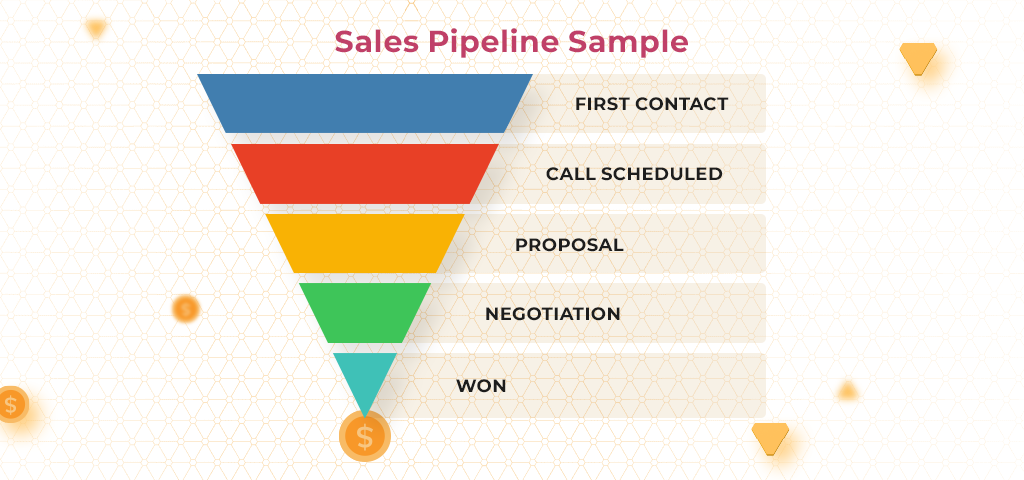For your business to be in tip-top shape, your pipeline must be first. A topped up and ticking over pipeline can be a door to a brighter business future. NetHunt have got the keys to show you how.
Let’s take it from the top. A sales pipeline is a visual representation of a business’s sales process. It shows where leads, prospects, and existing clients are on their journey down to conversion. Sales people use pipelines to see what they need to do next.
Pipelines are often visualised as horizontal bars or funnels, divided into different stages of a sales process. Potential buyers move from one stage to the next as they go through the pipeline; setting off different triggers for what needs to be done next. Oh, look... here comes one now!

An absolutely classic pipeline, there.
Sales pipeline management is the general term for organising leads, prospects, and existing clients along your pipeline. Despite how elusive good pipeline management can be, it is absolutely pivotal to meeting objectives, maintaining good customer relationships, and making money.
Alas, there’s not much point in knowing what it is if you don’t know how to use it. Here are NetHunt’s six keys to magnificent pipeline management.
KEY #1: KEEP IT CONSISTENT
Everybody wants to put their own stamp on a process, create their own sales routines, and make a name for themself. The truth is, it’s not good for business. When sales reps get too creative, things get messy. Clients receive mixed messages and go cold more easily. It’s important to have your sales team reading off the same script. The first key to good pipeline management is consistency.
That doesn’t necessarily mean your sales people should be reading off the actual, same script. It means that each stage in your sales pipeline should be clearly set, equally weighted, and have designated actions that are taken once a customer has reached it.
Let’s imagine a prospect has reached “Stage 3 - Proposal” in our sales pipeline. They’ve been contacted, had a live demo, and now they’re getting into the nitty gritty of choosing between whose services they want. This would be a good time for them to check out some third-party reviews to weigh up the pros and cons; each prospect in this stage could be sent a friendly link to push them along.
KEY#2: KEEP IT REVIEWED
Your pipeline is a living, breathing entity. It is your pet. If you don’t look after it, it will die. The best sales organisations regularly review their pipeline points and techniques to make sure things are finely-tuned and über-optimised. Well-integrated pipelines offer data that can tell us a lot about our business; data that generally tells us that there’s always room for improvement.
Regular pipeline reports offer a lot of ammo for your sales meetings. You should look at the number of deals in your pipeline to understand how much manpower is needed. You should look at the average size of deals in your pipeline to keep an eye on the general health of your business. You should look at the win/ lose ratio of deals to either give your team the praise or rollocking they deserve.
Finally, you should review sales velocity. Your processes need to be short. Sales velocity is a measurement of how quickly leads move through the pipeline, and how much value new customers provide over time. The longer a lead is left hanging around the pipeline, the more likely they are to fall out of it. If you’re losing a lot of business one stage in particular, it might be time to cut it out of your pipeline to keep that sales velocity ticking over.
KEY #3: KEEP IT CLEAN
You can spend days, weeks, months speaking to clients; buttering them up… falling in love with them. They could quite literally be your soulmate but have not made any progress up the pipeline. If they haven’t… it’s time to get rid.
It can be a difficult habit to get into. It might feel like you’re cutting somebody loose before their love affair with your product has even begun. The truth is that if a lead isn’t interested, they’re not going to buy your product. If this is the case, then they simply shouldn’t be clogging up your pipeline, taking valuable attention.
Apart from simply not answering you, there are 3 general signs that a lead isn’t interested…
- They keep telling you ‘some other time’ - if they were truly interested, they’d find the time for you.
- They won’t introduce you to other contacts within the company - you might have got in touch with a middleman, and need to speak to somebody higher up in the chain.
- They aren’t engaged in the sales process - they might have expressed interest, but never checked out your content, visited your website, or followed up any of the information you sent them.
KEY #4: KEEP IT PRIORITISED
With the previous point in mind, it’s important to remember that this isn’t a binary choice. Some prospects aren’t a yes or a no, but rather somewhere in the middle. Some leads are more likely to be worth your time, in a position to spend some money; some might still be doing the sums. It’s important that the most actionable leads are worked on first, whilst the others are put on the backburner.
An effective way of prioritising leads is by lead scoring. This is a methodology used to rank prospects based on their likelihood of buying. The method of scoring might differ from organisation to organisation, but the basic principles remain the same. The higher the number, the higher the priority.
- Define Marketing Qualified Leads (MQL)
An MQL is a lead who is very likely to become a customer based on key data points, such as demographics, internet history, or social connections. Our MQLs are closely linked to our buyer personas. - Establish a system
Assign criteria for giving points. For example, a lead might receive one point for every telephone call they answer. - Assign actions to points
When a lead has reached a certain point threshold, they should trigger some sort of action. It’s time to organise a meeting with them, or to ramp up the base touching.
Focus on quality, rather than quantity and you will, naturally, sell at a faster pace.
KEY #5: WORK AS A TEAM; KEEP IT CONTENT
Scheduled meetings, Zooms, and Skypes are great and all… but it all needs to be supplemented with red hot content. A sales pipeline shouldn’t only be visible to your sales team, but to your marketing team as well. Having the two branches of your business working in unison offers a much better customer experience, more value, and eventually pushes them down the pipeline.
Generally, marketers are the creatives of the business world; sales managers are more interested in numbers.
Having creativity to backup the business-brains means the consistent processes, that we laid out earlier, can be personalised and highly-targeted. Blog posts, case studies, videos, eBooks, and everything else the marketing machine pumps out can help reinforce a message and provide credibility.
MASTER KEY: KEEP IT AUTOMATED
Setting up a sales pipeline from scratch seems like a lot of work. It is. Luckily, CRM is software sent from the pipeline gods themselves. Sales technology is advancing to manage the volume and velocity of your pipelines. A good customer relationship management system can help you keep up as things start to gain traction. With the ability for multiple team members to manage one deal, it’s all hands on deck to get it across the line.
NetHunt CRM is natively integrated with Gmail. It provides sales teams with multiple, fully customisable pipelines that can be set up to meet a business’s different needs. It keeps all client data in one place, such as communication history, notes, and events, so everybody has a precise insight into where they are in their pipeline. The reporting feature offers access to the metrics that are so important when managing pipelines.
You might as well give our 14 day trial a go. It’s free!
Your pipeline is your business. Keeping it clean, consistent, coherent, reviewed, prioritised, and automated keeps your business all those things too. These are the keys to a brighter business future. Grow better; grow happier.
Table of Contents
Crack the sales formula with CRM Lab
Twice a month, receive actionable CRM content to your inbox.

